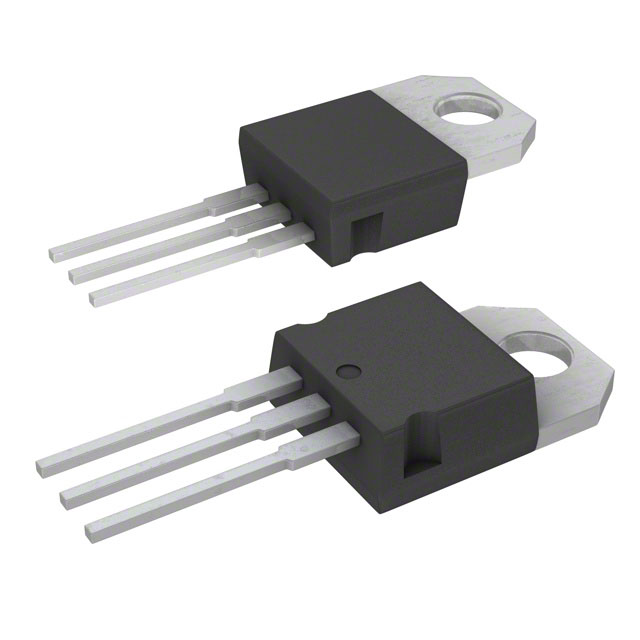Consulte las especificaciones para obtener detalles del producto.

TIP42A Transistor
Introduction
The TIP42A is a PNP (positive-negative-positive) bipolar junction transistor (BJT) that belongs to the category of power transistors. It is commonly used in electronic circuits for amplification and switching applications due to its high current and voltage capabilities.
Basic Information Overview
- Category: Power Transistor
- Use: Amplification and Switching
- Characteristics: High current and voltage capabilities
- Package: TO-220
- Essence: Power amplification and switching
- Packaging/Quantity: Typically sold in packs of 10 or 25 units
Specifications
- Collector-Emitter Voltage (VCEO): 60V
- Collector-Base Voltage (VCBO): 60V
- Emitter-Base Voltage (VEBO): 5V
- Collector Current (IC): 6A
- Power Dissipation (Pd): 65W
- Transition Frequency (ft): 3MHz
Detailed Pin Configuration
The TIP42A transistor has a standard TO-220 package with three leads: 1. Base (B): Input terminal for controlling the flow of current 2. Collector (C): Output terminal for the amplified current 3. Emitter (E): Ground terminal for the current flow
Functional Features
- High current gain (hFE)
- Low saturation voltage
- Fast switching speed
- Good linearity in amplification
Advantages and Disadvantages
Advantages
- High power handling capability
- Suitable for audio amplification and power switching applications
- Robust construction for reliable performance
Disadvantages
- Relatively larger package size compared to smaller signal transistors
- Higher cost compared to low-power transistors
Working Principles
The TIP42A operates based on the principles of bipolar junction transistors, where the flow of current between the collector and emitter is controlled by the base current. When a small current flows into the base, it allows a larger current to flow from the collector to the emitter, enabling amplification and switching functions.
Detailed Application Field Plans
The TIP42A transistor finds extensive use in various electronic applications, including: - Audio amplifiers - Power supply circuits - Motor control systems - LED drivers - Voltage regulators
Detailed and Complete Alternative Models
Some alternative models to the TIP42A transistor include: - TIP41A - TIP41C - TIP42C - MJL4281A - MJL4302A
In conclusion, the TIP42A transistor is a versatile power transistor with high current and voltage capabilities, making it suitable for a wide range of amplification and switching applications in electronic circuits.
[Word Count: 366]
Enumere 10 preguntas y respuestas comunes relacionadas con la aplicación de TIP42A en soluciones técnicas
What is the TIP42A transistor used for?
- The TIP42A is a PNP power transistor commonly used in high-power amplifier and switching applications.
What are the key specifications of the TIP42A transistor?
- The TIP42A has a maximum collector current of 6A, a maximum collector-emitter voltage of 60V, and a maximum power dissipation of 65W.
How can I use the TIP42A in a high-power amplifier circuit?
- The TIP42A can be used as the output transistor in audio amplifier circuits to drive high-power speakers.
Can the TIP42A be used in a switching power supply?
- Yes, the TIP42A can be used in switching power supply designs to control high-current loads.
What are the typical applications of the TIP42A in technical solutions?
- The TIP42A is commonly used in audio amplifiers, voltage regulators, motor control circuits, and LED drivers.
What precautions should be taken when using the TIP42A in a circuit?
- It's important to ensure proper heat sinking and thermal management due to the high power dissipation of the TIP42A.
Can the TIP42A be used in automotive applications?
- Yes, the TIP42A can be used in automotive electronic systems such as power window controls and motor drivers.
What are the typical operating conditions for the TIP42A?
- The TIP42A operates within a temperature range of -65°C to 150°C and requires a minimum hFE (DC current gain) of 15 at a collector current of 3A.
How does the TIP42A compare to other transistors in its class?
- The TIP42A offers high current capability and low saturation voltage, making it suitable for demanding applications.
Where can I find detailed application notes for using the TIP42A in technical solutions?
- Detailed application notes for the TIP42A can be found in the manufacturer's datasheet and application guides, as well as in technical reference books on power transistors and amplifier design.

